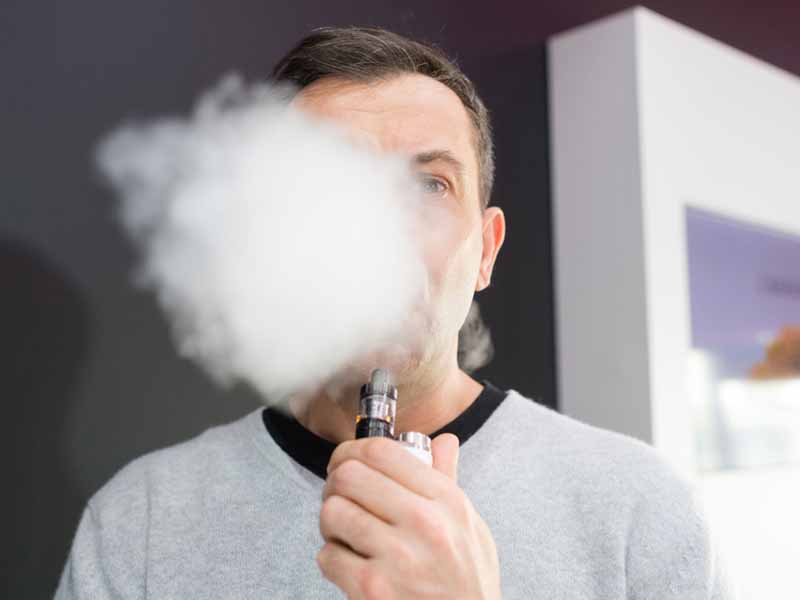Study: E-cigarettes Top Nicotine Replacement for Quitting
AAFP Cautions: E-cigarettes Still Contain Addictive Nicotine
February 13, 2019, 01:37 pm Chris Crawford – In late January, the New England Journal of Medicine published a study comparing e-cigarettes' effectiveness in helping smokers quit with that of nicotine-replacement therapy. The primary outcome of interest was sustained abstinence at one-year followup.
Results of the study showed that e-cigarettes were more effective for this purpose than nicotine-replacement therapy when both interventions were accompanied by behavioral support, with nearly twice as many e-cigarette users remaining abstinent from tobacco at one year as nicotine-replacement users.
The U.K.-based study, which used data gathered from three National Health Service (NHS) service sites from May 2015 through February 2018, randomly assigned 866 adults who were enrolled in NHS stop-smoking services (which are free in the United Kingdom) to either the nicotine-replacement products of their choice (three-month supply) or an e-cigarette starter pack, with a recommendation to purchase further e-liquids in the flavor and strength of their choice.

Weekly behavioral support was provided for participants in both groups for at least four weeks; the primary outcome was sustained abstinence for one year, which was validated biochemically at the final visit.
Of participants who completed the study, the one-year abstinence rate was 18 percent for the e-cigarette group compared with 9.9 percent for the nicotine-replacement group.
Story Highlights
It's worth noting, however, that among participants with one year of abstinence, those in the e-cigarette group were far more likely than those in the nicotine-replacement group to still be using their assigned product at 52 weeks -- 80 percent versus 9 percent, respectively.
Additional findings included more frequent reporting of throat or mouth irritation in the e-cigarette group (65.3 percent) than the nicotine-replacement group (51.2 percent), and nausea was more frequently noted by nicotine-replacement users (37.9 percent) than e-cigarette users (31.3 percent).
The e-cigarette group also reported less coughing and phlegm production from baseline to 52 weeks than did the nicotine-replacement group; there were no significant between-group differences in the incidence of wheezing or shortness of breath.
Additional Study Details
Participants in the nicotine-replacement group were offered a wide range of available products (patch, gum, lozenge, nasal spray, inhalator, mouth spray, mouth strips and microtabs) and were able to select their preferred product.
Combined use of these products was encouraged, and use of the patch along with a faster-acting oral product was typical. Participants also were free to switch products during the trial.
Those in the e-cigarette group received a starter pack designed to facilitate initial use and teach participants how to operate refillable e-cigarette products; a 30-ml bottle of e-liquid containing nicotine at a concentration of 18 mg per ml also was provided.
Participants were asked to purchase further e-liquid supplies online or from local vape shops and to buy a different e-cigarette device if the one supplied did not meet their needs.
Family Physician Expert's Impression
Thomas Houston, M.D., of Dublin, Ohio, past chair of the AAFP's Commission on Health of the Public and Science and Smoking Cessation Advisory Committee, told AAFP News that overall, he thought the study was well designed and conducted.
"The electronic-cigarette arm, however, did not mimic the way these devices are usually used by smokers in quit attempts -- the counseling that accompanied the e-cigarettes in the study is not a part of real-world quit attempts with e-cigarettes."
And although the researchers positively touted that 80 percent of participants in the e-cigarette group continued e-cigarette use at one year, Houston said this might not be great news.
"That is actually concerning, given that nicotine addiction was perpetuated, and the safety of e-cigarettes in such situations is not known," he said. "We don't know enough about the long-term health effects of e-cigarettes to say that they are safe, and there have been studies pointing out the potential cardiac and pulmonary risks, for example."
When compared to combustible cigarettes, Houston said that e-cigarettes have fewer toxic components/chemicals, so there may be a degree of "harm reduction," adding that FDA-mandated safety studies are needed to more clearly define the safety of e-cigarettes as a cessation tool.
The AAFP currently does not endorse e-cigarettes as a cessation device. The Academy does, however, support the U.S. Preventive Services Task Force's recommendation on tobacco use in adults, which says clinicians should ask all adults about tobacco use, advise those who use tobacco to stop, and provide behavioral interventions and FDA-approved pharmacotherapy to help tobacco users quit.
As for limitations to this study, Houston said risk data were lacking, along with the potential that nicotine dependence was being perpetuated.
Better Education Needed
Houston said family physicians, parents and personnel working in school systems need to continue to educate children and adolescents about the addictive nature of e-cigarettes, including the leading brand, JUUL.
"Nicotine in JUUL is as addictive as that in cigarettes, can influence the developing teen brain and creates a strong risk that these children will move on to conventional cigarettes," he said. "In addition, the wave of JUUL use normalizes smoking and nicotine use in the teen population."
Houston suggested family physicians start their educational efforts by using the AAFP's resources on tobacco and nicotine prevention and control, which include tools for use in physician practices and the community.
For example, the AAFP's Tobacco and Nicotine Cessation Toolkit is among the many resources included in the Academy's Ask and Act tobacco cessation program.
"Ask and Act (or the 5As) incorporates evidence-based methods for cessation that we should be using with all patients who use tobacco, including intake and assessment, advice and counseling/referral, use of FDA-approved pharmacotherapy, and good followup," Houston said.
"The longitudinal relationships FPs have with patients give us an advantage in treating this chronic disease," he added.
Related AAFP News Coverage
CDC: Adolescents Curious, Susceptible to Hookah Smoking
(1/23/2019)